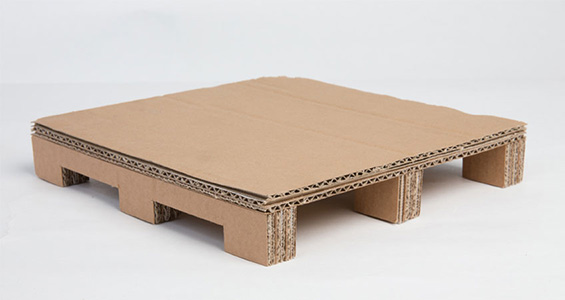A Forklift Operator’s Guide to Pallet Handling
Variety, they say, is the spice of life. However, when you are trying to get consistent performance out of logistics operation, variety can be a productivity killer. This principle certainly applies to pallets and pallet handling.
The lion’s share of goods in motion are stacked on pallets. Traditionally, pallets were made from softwood, like pine, or hardwood, like oak, and came in a standard size mandated by the Grocery Manufacturers Association (GMA). These “GMA” pallets had a standard size of 48 in. by 40 in.

However, times have changed, and not only are there different-sized pallets here in North America but there are a variety of internationally-sized pallets. This becomes important for forklift operators particularly when it comes to rack storage of pallets that may not be standard-sized.
And, as material science has developed, pallets made from a variety of different materials have emerged–plastic, metal and corrugated paper. Although most have forklift fork openings, there are some handling differences that forklift operators should be aware of in order to safely and efficiently move goods loaded on the various types of pallets.
As the workhorse of the logistics world, pallets take a lot of beating. They also bear the brunt of the goods that they carry. And they’re designed to be used a multitude of times. Here are some tips to help forklift operators safely and efficiently use pallets.

- Always wear cut-resistant gloves when handling pallets, especially wood pallets. Pallets aren’t light as a feather and can have splinters, nails and screws sticking out. They can cause a nasty injury if not handled properly.
- Pallets should be inspected before use. Cracked deck boards, stringers or blocks can reduce a pallet’s load capacity, and damaged pallets should be discarded or sent out for repair. For plastic pallets, look for cracks or deformities. Metal pallets that are bent or cracked should not be used.
- Pallets do vary by weight-bearing capacity. The standard GMA stringer pallet has a minimum load-bearing capacity of 2,500 lb., and a GMA block pallet can accommodate a load of up to 4,600 lb., but there are other factors to consider when using different pallets for heavy loads:
- Static load capacity – This is the weight-bearing capacity of a pallet with a load at rest.
- Dynamic load capacity – This is the minimum evenly-distributed weight a pallet can bear when being lifted and moved with a forklift
- Edge rackable load capacity – The maximum weight a pallet can handle when stored on a rack with two edges. This is important for standard pallet racking (front and rear beam support), drive-in, or push-back racking supported with side rails.
- Don’t store empty pallets on their sides. Pallets are designed to be horizontally stored. Leaning pallets up against a wall or column can cause them to tip over and take out your foot.
- Pallets can weigh up to 100 lb. If you need to lift a pallet, be very careful. Bend your knees when lifting or get someone to help you. Make sure your footing is secure so you don’t slip.
- Avoid standing or walking on pallets. They can have exposed nails or screws that can cause injuries. Not to mention that a wet pallet can be slippery and be a fall hazard,
- When placing a load on a selective rack, be certain that the legs of the pallet are lined up with the beams and cross braces of the rack.
- Clean up after using pallets. Before you store them, make sure pallets are free of spilled product, mud or other debris. Store pallets in a dry place. Discard or recycle any pallets that appear to be damaged.


Tapered/blunt forklift forks
Some specific tips for moving plastic pallets with a forklift:
- With plastic pallets, use blunt-end or tapered forks. Sharp forklift forks can damage plastic pallets.
- Avoid dropping plastic pallets. They can crack more easily than wood pallets.
- Don’t use your forklift as a battering ram. Impacting a plastic pallet with a forklift can cause it to crack.
- Insert forks all the way into the pallet. Don’t try to save time by inserting the forks only part of the way. That can cause a plastic pallet to crack.
- Don’t push or drag a plastic pallet along the floor with a forklift.

What about corrugated paper pallets?
Corrugated paper or cardboard pallets are beginning to make inroads in the logistics arena due to their lightweight strength, and ability to be recycled. Some large companies, like Ikea, have standardized on corrugated pallets. Corrugated pallets can be made in customized shapes, too. Like round. Here are some tips on handling corrugated pallets.
- Corrugated pallets are not designed for rough handling. Do not push or drag a loaded corrugated pallet along the floor. Carefully position the forks and lift the load gently.
- Corrugated pallets can’t be used with open racking. Make sure you store corrugated pallets on supported rack.
- Avoid getting corrugated pallets wet. They will lose their integrity. Be cautious with using corrugated pallets in cold chain operations.
And let’s not forget slip sheets. Some shippers have ditched the pallet and moved on to cheaper, easy to dispose of, slip sheets. See our blog on how to handle them.
Your Apex representative is your in-house expert in the proper storage and movement of palletized goods. We can help you configure your warehouse to handle loads on any type of pallet–or even not on pallets at all–and recommend the best combination of forklifts and accessories to handle those loads. Apex is your warehouse and material handling superstore in the Chicagoland area.
